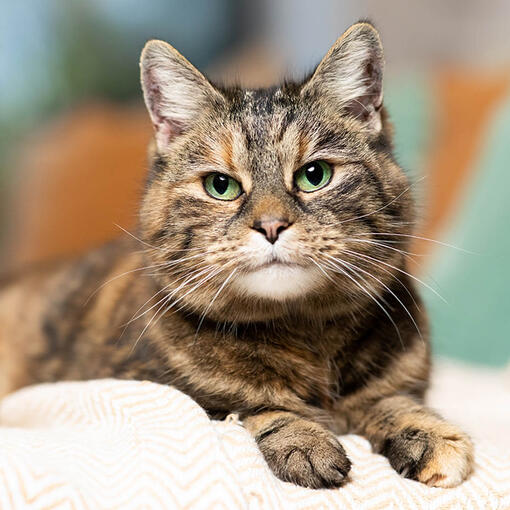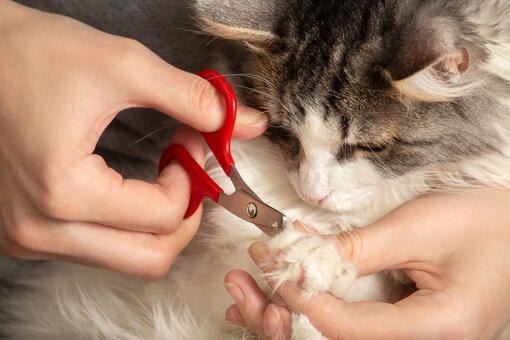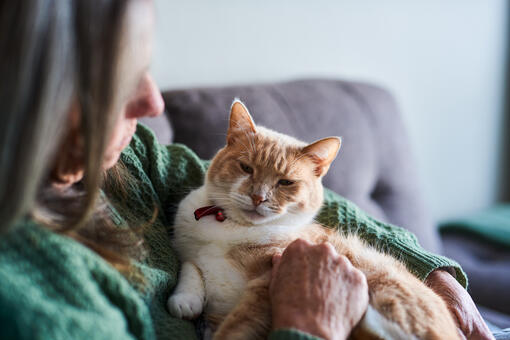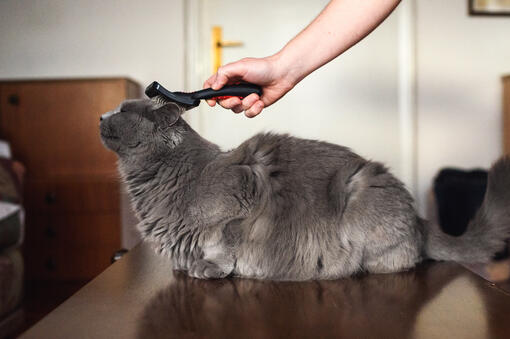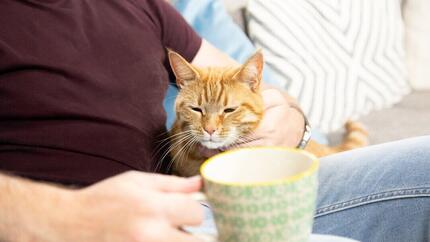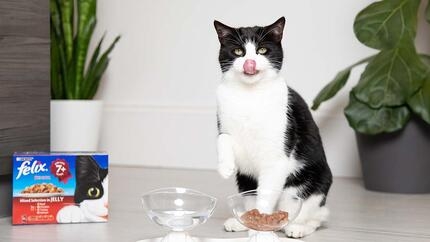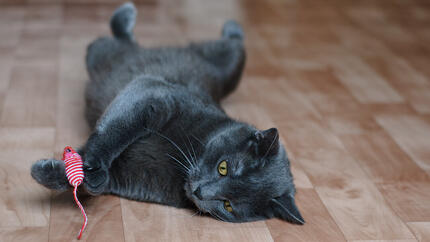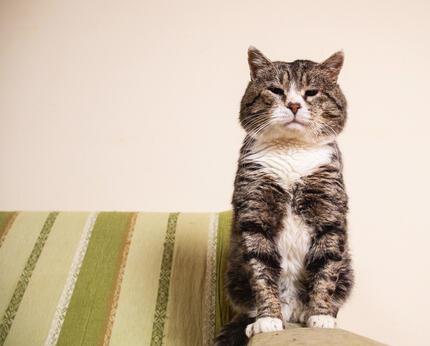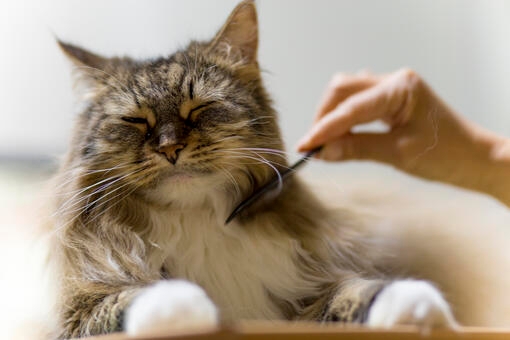
Understanding Your Senior Cat's Grooming Needs
As cats age, they may face several grooming challenges.
Common age-related health issues such as arthritis or becoming overweight can reduce their flexibility and so make self-grooming much more difficult for them. This can lead to dandruff, unkempt fur and unhealthy skin.
Other conditions, such as hyperthyroidism, diabetes, and kidney issues, can also affect a cat's coat and skin. Older cats with these conditions may require extra care to remove dead hair and manage excess skin oil, preventing matting.
It’s also common to see changes in their coat texture and skin health as cats age. Some ageing cats have an increase in the naturally produced oils from their skin, which can cause mats – often at the base of their tail and up their back.
A sudden reduction in your cat’s self-grooming is always a cause for concern – especially if they are usually fastidious. It could indicate mouth or dental problems, pain or disease, and you should always contact your vet.
Top Tip: Look for signs that your senior cat may need help grooming themself. These can include matted fur, dandruff, an unkempt appearance, itchiness, or increased hairballs. If your cat seems to be starting to have issues to grooming themself, it's time to step in and help them.
Brushing Your Senior Cat
Regular cat brushing will help maintain the health of your senior cat's coat, especially if they are not quite as efficient at keeping themselves clean and tidy as they were in younger days. Some long-haired cats and certain breeds often require extra grooming, especially as they age. Brushing will help to remove loose hair, prevent matting, and stimulate the skin, promoting better circulation and the distribution of natural oils.
All cat owners should spend time grooming their cats when they are younger and getting them used to being brushed. This is a great bonding opportunity, enjoyable for both you and your cat, and prepares them for their more senior years when you will need to give them additional grooming help. As your cat ages, they may become less active, and it is easy for boredom to set in. Grooming your cat is a wonderful social opportunity when your cat needs companionship and interaction.
Top Tips
Use a gentle approach when brushing your senior cat especially if they are not used to being brushed. As a cat ages, their skin becomes thinner and more delicate so it is important to find a soft brush that will be comfortable for your cat and make grooming enjoyable.
Start with short periods of grooming, brushing only the areas your cat enjoys (so avoiding face, paws, stomach etc) and gradually increase brushing time as your cat becomes more comfortable. Once they are more comfortable with you brushing them, you can start to venture into more sensitive areas. Avoid forcibly restraining your cat. If they are not enjoying it, or if the interaction becomes too intense for them, let them leave. You want to teach them that grooming is pleasurable and not an ordeal. Always brush in the direction of hair growth to avoid causing discomfort.
Brushing long-haired cats requires even more attention, as they are prone to getting tangles and mats. Mats refer to clumps of tangled fur that form when a cat's hair becomes knotted and intertwined. They can be uncomfortable or even painful for the cat, leading to skin irritation or infections if not properly managed. It is important to not let these form as they can be difficult and uncomfortable to remove. Use a wide-toothed comb to gently detangle any knots and follow up with a soft brush to smooth the coat. Regular brushing will keep their fur looking beautiful and healthy – and prevent mats before they form.
Nail Trimming and Claw Care
With reduced exercise and activity – especially in outdoor cats – you can often begin to see excessive claw growth.. Regular cat claw trimming is essential to prevent overgrown nails, leading to pain, difficulty walking, and getting claws stuck in soft furnishings which can be distressing and cause injury. Not only that, but over-grown sharp claws can cause injury to their more delicate skin – and to yours!
Keeping your cat's nails at a manageable length is a key aspect of their overall health.
The very best thing you can do is to take steps to prevent claws getting overgrown in the first place and to help your cat with their own claw care. Older cats are less active and may be spending more time indoors or in certain rooms.
Here are some tips to make the experience as stress-free as possible:
- Have scratching posts/opportunities in various places in your home to replace any reduced outdoor favourites. If they have an outdoor catio, make sure there are scratching opportunities there too.
- Encourage indoor claw care – in appropriate places. Spend time finding out what kind of surfaces your cat prefers to use for their pawdicures. Some like wood, while others enjoy sisal, cardboard, or carpet. Most cats like vertical scratchers whereas others, especially if stiff or with reduced mobility, might find something horizontal easier. The easier access scratching opportunities your older cat has, the more they are likely to continue their own claw care even if they have reduced mobility.
- Encourage scratching in these areas by putting them in places where your cat has easy access, often grooms, where they feel comfortable, or where they play. You can use catnip to encourage them – or treats if that is their preference.
While most cats can manage their own claw care, there may be times when they need a little extra help. If your cat travels well, consider having a vet nurse trim their claws. They are experts at doing this quickly and stress-free. However, if your cat finds travel stressful, you might need to do it yourself.
Before trying to trim your cat's claws, a few preparations are necessary for a successful and stress-free experience.
Get your cat used to having their paws handled by gently stroking them during grooming or relaxed moments. Gradually increase the duration, holding their paw briefly. If they seem worried or pull away, slow down.
- Get someone to teach you how to do it first. Ask your vet nurse or a local groomer to show you how to clip claws and, ideally have a go yourself under supervision. This will make you much more confident – and far quicker – when you clip your own cat’s claws.
- Prepare Your Tools: Make sure you use purpose cat clippers (not your own) and have everything to hand before you start. Close doors and windows – and if you have someone with you your cat knows and trusts, an extra pair of hands can be helpful.
- Choose the ideal time: Trim your cat's nails when they are relaxed and calm – and ideally sleepy. Make sure they are comfortable but, in a place, you can keep them secure.
- Gently Hold the Paw: Hold your cat's paw and apply gentle pressure to extend the nails. Don’t squeeze them as this will be uncomfortable or even painful for your cat.
- Trim the Tips: Only ever clip the white bit at the very tip and you must, avoid the quick (the pink part inside the nail). If you accidently cut into the pink part this will be extremely painful for your cat and will cause bleeding. Your cat will probably never let you near their paw ever again.
- One at a time: Only do one paw at a time and then reward with a treat or a game. Trying to do all four at once will just stress your cat.
- Reward and Praise: Reward your cat with treats and praise to create a positive association with nail trimming.
Managing Overgrooming
Cat overgrooming can be a sign of boredom, stress, anxiety, or underlying health issues in senior cats. Look for signs such as excessive licking, bald patches, or skin irritation.
As a cat ages, they become less active and often get less enrichment opportunities. This can lead to boredom – and with boredom and nothing to fill their day, can come overgrooming.
Make sure you provide enrichment opportunities for your older cat. This could be easily accessible cat trees, tunnels, window-ledge viewing opportunities, food dispensing toys, games with you, and spending more quality time with them. Remember that while they may be less physically active, they still need mental and social stimulation to prevent boredom.
Make sure you provide enrichment opportunities for your older cat. This could be easily accessible cat trees, tunnels, window-ledge viewing opportunities, food dispensing toys, games with you, and spending more quality time with them. Remember that while they may be less physically active, they still need mental and social stimulation to prevent boredom.
Creating a stress-free environment can help reduce overgrooming. Provide plenty of enrichment and safe spaces for your cat to relax. You could also consider using calming products such as pheromone diffusers or supplements designed to reduce anxiety.
Overgrooming can lead to skin infections, sores, and hair loss. If you notice signs of cat overgrooming – especially if these have a sudden onset - consult your vet to rule out any medical conditions and if diagnosed, to discuss potential treatments.
Bathing Your Senior Cat
Bathing your older cat is definitely best avoided, however there are situations where a cat bath may be necessary, such as when they are unable to clean themselves due to illness or if they get into something dirty.
Follow these simple steps:
- Prepare the Bath Area: Use a sink or a small tub with a non-slip mat.
- Use Lukewarm Water: Fill the tub with a few inches of lukewarm water.
- Gently Wet Your Cat: Avoid the face by using a cup or sprayer on your cat.
- Apply Cat-Safe Shampoo: Use a shampoo specifically designed for cats and gently lather it into their fur.
- Rinse Thoroughly: Rinse all the shampoo out to prevent any residue from irritating the skin.
- Dry Your Cat: Use a soft towel to gently dry your cat, keeping it warm until it is completely dry.
Choose gentle shampoos and conditioners formulated for cats. Look for products free from harsh chemicals and fragrances and specifically designed for sensitive or ageing skin.
Grooming Tools for Senior Cats
There are various grooming tools available to help keep your senior cat's coat in top condition. These include:
Brushes: Different types for different coat lengths.
Combs: Gentle wide toothed combs can be useful for removing mats
Self-Groomers: These are often sisal arches or posts that cats can rub against to help groom themselves.
Choose tools that are gentle and easy to use. Soft-bristle brushes are ideal for sensitive skin, while self-groomers can provide a convenient way for your cat to groom themselves.
Nutrition and Grooming
A balanced diet plays a crucial role in maintaining your senior cat's fur and skin health. Senior cat food is formulated to meet the specific nutritional needs of older cats, promoting a healthy coat and skin.
Supplements such as omega-3 fatty acids can improve coat condition and reduce shedding. consult your veterinarian before introducing any new supplements to your cat's diet.


